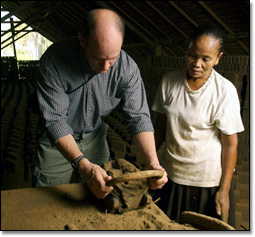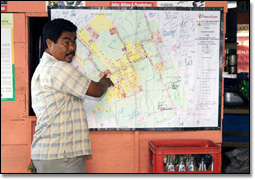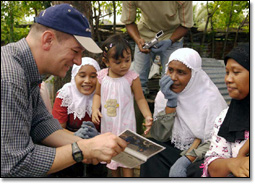Bob Seipel, a program manager for Boeing Space & Intelligence Systems Mission Systems, is reporting for Boeing News Now this week from Banda Aceh, Indonesia. He is part of a delegation led by the company's Global Corporate Citizenship function to investigate the progress of the rebuilding in Aceh province on the island of Sumatra, one of the areas hit hardest by the December 2004 Southeast Asian tsunami.
Boeing employees and retirees' donations accounted for nearly $2 million of the total Boeing contributions of $4.5 million split among three international relief agencies -- the American Red Cross, Mercy Corps and CARE, the latter two of which are sponsoring this site investigation. It is Seipel's responsibility on this trip to be the eyes and ears of Boeing employees and retirees who gave so generously to this disaster and to report back on how their dollars and those of the company are being spent in the relief efforts.
Each days events: Day 1, Day 2, Day 3, Day 4, Day 5
Day 3, JAN 31:
Getting our hands dirty

Boeing's Bob Seipel tries his hand at brick-making while a worker in the factory looks on. She makes up to 1,300 bricks each day. (Photo courtesy of Mercy Corps)
Today was our last day with our Mercy Corps guides. Our group has developed an easy relationship with the Mercy Corps team members who have been showing us around the Aceh countryside for the past two days, explaining the nature of their work with the people of the province. All of this took a great deal of coordination and planning, and we are grateful for their time, patience and hospitality. It was difficult to say goodbye, and I suspect they will be difficult to forget as well.
But before we were handed off to our CARE guides at midday, we were able to take in three more projects Mercy Corps has funded in the province. The first was the most hands-on of our visits here, and I mean that literally. In a village called Lam Ujong, we were taken to a small group of modest buildings that house a brick-making operation consisting of a kiln and two thatched-roof open-air structures where the bricks are made and dried. The factory employs four people, actually two couples, from the village. Brick factories like this one are fairly common in the area since the soil here contains mostly clay.
What made the brick operation we visited unusual is that it is owned by the community rather than a private individual as is typically the case. Deciding as a group and on their own initiative, community members took the $1,200 cash grant provided by Mercy Corps to rebuild a brick factory destroyed by the tsunami as a means of ongoing income generation for village members.
The factory is being leased for two years to a man from the village. His rent is an eight percent cut of the 45,000 bricks a month he produces, which the community sells for about $120 to fund a variety of needs, including hiring a teacher for the children, scholarships and funding start-up businesses in the village. Since mid-June 2005, the village has raised more than $1,600.
The highlight of the visit came when a woman named Paini, hard at work making bricks, allowed me to try making a few of my own.
She showed me how to take a large lump of clay and throw it hard -- she indicated I didn't do it hard enough at first -- into a wooden form, after which a scraping tool is used to level it out. The form is raised, and the still-wet brick is carefully laid on a pile of other drying bricks. It is difficult, gritty, repetitive work. Paini can produce an amazing 1,200-1,300 bricks a day. In the time I took to make two badly formed ones, she probably could have made at least 10. She assured us she would catch up. The factory owner presented me with a sample of a final product before we left, and I will treasure it always.

Samsul, the head of the planning committee in Lam Asan Klieng, presents the village's 10-year plan for rebuilding and future development. (Photo courtesy of Mercy Corps)
Our next stop was a visit with the village planning committee in Lam Asan Klieng, which is about 80 acres in size with a population of 370. Villages being rebuilt from scratch are required by the Indonesian government to have detailed 10-year plans that take into account location and design of housing, schools, community centers, infrastructure, sanitation, etc. The plan also includes details about future expansion, given a projected growth rate of four to five percent a year.
Mercy Corps is one of the organizations facilitating the planning process in cooperation with the government, providing planning tools and professional consultants that meet with the villagers to develop a plan that makes the best use of the land and is environmentally sound. The entire village must agree to and sign the plan before any work can start -- signatures of all shapes and sizes were scattered all over the plan we saw. Reaching consensus was an arduous process for the planning committee, we learned, but it ensures a sense of ownership and commitment that would not be realized otherwise.
Next we visited Miruk Lamreudeup, a village whose population was cut in half by the tsunami. There we saw an organic gardening project headed up by the village women, which just started up after seven weeks of planning and preparation. The small plot of land had been donated by one of the women; it is literally her backyard.
When we arrived, 20 women of a variety of ages were hard at work clearing the plot of overgrown tropical vegetation. Graciously, they stopped what they were doing to speak with us. Several we talked to had other jobs, working in a brick factory or one of the kiosks that sell food and other items. One woman was a midwife with 50 deliveries to her credit.
They said they were concerned about their children's health and the need to find a way to keep the community clean of garbage and other waste. Like most mothers anywhere, they want a better life for their children, and they are willing to do what it takes to make that happen.

Seipel shows pictures of his three sons to some of the women who are participating in an organic garden project in Miruk Lamreudeup that is funded by Mercy Corps and Green Hands. (Photo courtesy of Mercy Corps)
We learned from our guides that the garden is meant to grow vegetables for the consumption of the women and their families, and eventually, if all goes well, for sale to the rest of the village to provide an additional source of income. Mercy Corps, along with another nongovernmental organization called Green Hands, is providing the necessary training, seeds, tools and fencing materials to the participants. It is a pilot project designed to promote long-term self-sufficiency for these communities and will be expanded to other villages if successful.
Although there is not an apparent lack of food here, we're told that poor nutrition is a problem in the province, with many children suffering from persistent anemia and other related ailments. Adding more vegetables to their diets will help.
As we said goodbye to our Mercy Corps guides, they underscored how the contributions from Boeing and its employees and retirees had given them the ability to innovate their approaches to addressing community needs and the flexibility to discover the best solutions in advance of implementation.
"The way we do our work even now was shaped and informed by what we learned in the beginning, which is leading to even greater positive impact than we would have expected otherwise," said Mark Ferdig, director of Aceh programs for the organization.
"When it comes down to it," he said, "it's really about trust -- your employees' trust that the company will be good stewards of their contributions, your trust in us that we will use these contributions wisely, and the communities trust that we will help them be self-sufficient and successful. We take that trust very seriously."
Our CARE contingent gave us a thorough presentation late this afternoon to set the stage for our next two days with them, and we are already impressed.
For more information about Mercy Corps' efforts in Banda Aceh and other tsunami-affected areas in the region, visit the organization's Web site.
|

